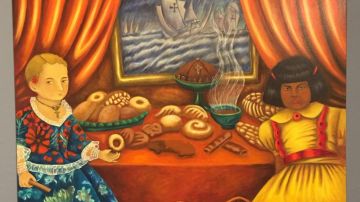Two Artists From the Chicano Civil Rights Movement Embrace Their Existence As Resistance
ASCO and Los Four were East Los Angeles Chicano art collectives during the Chicano Civil Rights movement in the 1970’s and early 80’s

Photo: Courtesy of Pacific Standard Time
ASCO and Los Four were East Los Angeles Chicano art collectives during the Chicano Civil Rights movement in the 1970’s and early 80’s. Judithe Hernandez (Los Four) and Patssi Valdez (ASCO) were the only female members of the group and as we see in literally everything–their work and contributions have been historically obscured–but what else is new? One Path Two Journeys highlights the work of the two most influential contemporary Chicana artists and let me tell you, it’s incredible. The gallery is literally offered as a pathway split in two, with Hernandez’s work on one side and Valdez’s on the other. It’s easy to see where the two paths collide ideologically and where they diverge stylistically, but the most interesting thing is how their individual artistic voice deals with the same topics of otherness, cultural identity, class, gender, immigration, the mythical and the rejection of eurocentricity. It’s also interesting to take stock of what has changed and what remains the same nearly 40 years later.

ASCO and Los Four were created in response to the lack of opportunities and treatment Chicanos experienced in East L.A. and the US at large. Whether it was failing schools, racism, police brutality, gang violence, or their fragmented cultural identity – Chicanos were looking for a way to express their frustration and use their voices to create social awareness inside and outside of the Chicano community. Judithe Hernandez is actually the fifth member of Los Four–they were known for their murals and taking political, hybridized Mexican imagery to the public sphere.

Hernandez’s studio works are an intersection of the philosophical, the religious, and the political. Borrowing from Renaissance, Greek, and Roman imagery–she merges the classical with indigenous motifs and christian iconography, exploring the imposition of one over the other as well as the social and ontological tension between the two. It’s moving and eerie. The women in her works often look peaceful or sad. Others look defiant or unaware, it is almost like the viewer is interrupting a private moment. And interestingly enough those are the private moments we often find within ourselves. Her muses raise the question caused by gender norms and cultural identity that we, as Latinas can never seem to find the answer to: “How do I define myself?” And to me, her answer is: “However you want.”
Valdez’s work, deals with similar themes but her background in performance art is evident in the richness and attention getting vibrancy of her paintings. ASCO also brought art to the streets, but they used costumes and impromptu public displays as the vehicle to express their dissatisfaction. Hernandez’s pieces are large and they are striking. They offer private looks inside homes, they depict dining room scenes, swirling carpets and floating objects. She too combines religious imagery with the traditional/indigenous either with the scenery and dress that surrounds her muses or the objects that can be found in the rooms she paints. Her surrealist influences are overt and like Hernandez, her works have a magical element that makes cabinets and birthday cakes unfamiliar and fantastic.

Her dark-skinned muses represent the two sides of the “Bi-national, transhistorical mestiza identity.” My favorite is “Pan Mexicano (A MERGING OF TWO CULTURES) in which two small girls (one indigenous, one white) stand in front of a table covered with an assortment of breads. They wear opposite cultural dress and in the background there is a painting of the Spanish ships on their way to conquer new territory. Both Valdez and Hernandez beautifully defy and reject any sort of uniform mentality that is used to define them as Chicanas. Instead they embrace their multifaceted existence as a form of resistance.
This exhibit ran from 09.01.17 – 01.28.18 at the Millard Sheets Art Center in Pomona, Ca.
Pacific Standard Time: LA/LA is a far-reaching and ambitious exploration of Latin American and Latino art in dialogue with Los Angeles. Led by the Getty, Pacific Standard Time: LA/LA is the latest collaborative effort from arts institutions across Southern California.

















